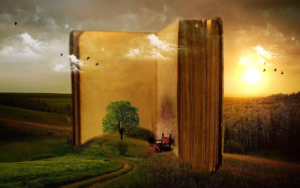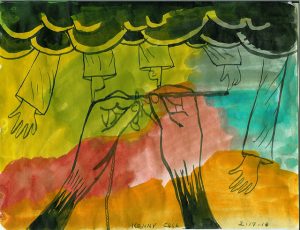Posts by Gwendolyn Womack
This playful post is inspired by a character I just finished writing for my next book. She has the ability to see auras, and I had a lot of fun assigning different colors to people seen through her eyes. It was like having a secret window into a character’s psyche, allowing us to know who the character really was and not just how they portrayed themselves to the outside world. In that way, color became a kind of subtext. And people’s auras kept surprising her—and in turn, will surprise the reader.
As the actual writer dreaming all this up, I also found aura colors to be shorthand for myself to help develop the character’s personality and mindset in a no-nonsense, cut-to-the-chase way. It was so helpful, fascinating, and refreshing to do.
So try taking a look at your characters and imagine what their aura would be if you could see it.
But what are auras, you might ask?
Auras are said to be the electromagnetic fields we emanate, and the colors of our auras are supposedly like the palette of our personality. It’s very similar to giving off a vibe. A person generally favors one or two colors, and sometimes that can fluctuate with their mood or health.
All the colors have meanings. There are different interpretations for them. You can find countless books, online articles, and videos about auras… How to see them. How to interpret them. How to find out what your colors are. But for the sake of this post, listed here is a very simple color summary I’ve been working from. Take a look and think about who in your story favors what color. It might help you to define them more.
Red: You are an adventurer with high energy, intensely passionate, strong willed, competitive, and ambitious. (Murky dark red – denotes being angry and confrontational)
Orange: Creativity abounds for you. You enjoy artistic pursuits and tackle challenges with a positive outlook. (Burnt orange – shows a lack of energy or being burned out)
Yellow: You have a sunny disposition and are charismatic, inquisitive, inventive, and at times eccentric. (Off yellow – being overly critical or scatterbrained)
Pink: With a loving nature, you are generous, caring, tender, and compassionate with others.(Murky pink – overly sensitive or insecure)
Blue: You are intuitive, a strong communicator, inspiring to others, imaginative, and value clear intentions. (Murky blue – feeling stifled, anxious, or judgmental)
Green: A nature lover, you are compassionate, giving, and hardworking. You are also determined and full of life. (Off green – feeling jealous, mean spirited, or overly stubborn)
Purple: You are highly empathetic, intuitive, introverted, a deep thinker, and love to ask the big questions about life. (Darker purple – excessively worrying or feeling insecure)
Gold: Wise and strong, you are seen as a leader and enlightened. (Off gold – being too proud or obsessive)
Pearl (rarest aura color): You have a pure heart and are spiritually inclined with the intention to help others. (Dark or murky pearl tones: feeling unbalanced)
Streaks or holes in an aura: You may be confused, depressed, or dealing with emotional trauma.
Deep Shadows: Could indicate you are ill or struggling with negative thoughts or emotions.
Please share with us in the comments below if you have any specific “personality” tricks to help you when you are creating characters. I’d love to know!
Good journey at the keyboard. From […]
Read MoreIn my last post, I talked about brainwaves and how they tie to intuitive writing. Alpha and Theta are the two brainwaves most conducive for deep creative work. Alpha is when our bodies and minds are in a relaxed, meditative state, and Theta generally occurs in the twilight of sleep when we’re about to start dreaming.
Stories are curated dreams captured on paper. So how can we quickly get into the proper brainwaves to daydream whenever we want—even in a noisy house or during a stressful day?
Sound
One extremely effective way is using sound. Sound has powerful effects on brainwaves, which is why drums, flutes, bells, and singing bowls are often used for transcendental meditation. The repetitive sound-wave from these instruments cause the mind to go into a Theta state.
So if you need to get in the zone quickly, and stay there, find an instrumental song that speaks to you and your story, something that can play almost unnoticed in the background. Then set it to repeat. The first time you play it looped, focus on getting into the zone and having a productive writing session. On the next day, use the same song. If you do this enough times, your mind will immediately enter Alpha state when the music begins to play. I find this very effective when I’m under a tight deadline and every moment at the keyboard has to count.
“Zen” Activities
When you step away from the keyboard, there are simple daily activities that automatically trigger an Alpha state. What if we take advantage of those times and use them to write?
Alpha activities include:
With our intention, we can turn these activities into effective writing times. You may not be at the keyboard (and perhaps worried you’re not) but it’s all about quality versus quantity. Visualizing your story while you’re doing something repetitive or relaxing often brings perfect answers to story problems and delivers memorable lines and dialogue.
So go into the activity knowing it will be writing time. Visually compose scenes in your head. If you drift off topic, that’s fine, just bring your focus back. Have a notebook or your phone nearby to dictate lines, ideas, or dialogue. Hang a “Do Not Disturb” sign to the rest of the word and work deep.
Art
Another Alpha-inducing activity I suggest trying is making a piece of art in solitude.
Think about something you could make that ties to your story. Go to Michaels or Hobby Lobby and browse for inspiration. Then schedule some alone time to unwind with your paints or putty and mull over your story. You’ll be surprised what inspiration strikes–because you’ve gone into a deep Alpha state. (I started practicing this with my second novel. The fun part is whatever I make I usually end up giving away at book events.)
Another idea is to jump on Pinterest to find images thematically tied to your story and simply gaze at them. Allow your mind to quiet and deliver whatever thoughts the artwork evokes. I make visual inspiration boards […]
Read MoreTherese here to officially welcome our newest contributor to Writer Unboxed, multi-published author Gwendolyn Womack! More about Gwen from her bio:
Gwendolyn Womack is the award-winning LA Times & USA Today bestselling author of The Fortune Teller, The Memory Painter, and The Time Collector. Her books have been described as cross-genre metaphysical thrillers, and her YA debut, The Premonitions Club, is coming out in 2025.
Gwen was a screenwriter for years before becoming a novelist and has an MFA in Directing Theatre & Film from CalArts. Her main hobby is photographing kaleidoscopes, and she often posts pictures of them on social media. She has taught writing workshops at conferences and for writing groups, both in person and online, and offers one-on-one consulting as well as editorial feedback.
Gwen’s well-storied background is sure to lead to some fascinating posts for us here at WU–and today’s post is the first proof. Enjoy. And welcome, Gwen! It’s great to have you with us.
Writing is an incredibly intuitive and often subconscious process. So the more we writers can train ourselves to build intuitive muscle, the more easily we can dive into characters’ psyches, figure out the narrative of the story, and cull our imaginations to answer that age-old question: What happens next?
While writing my second novel, a story revolving around an ancient Tarot deck, I began to think about how writing and intuition are intimately linked. Eventually, I created an Intuitive Writing workshop that I have led over the years, helping writers to tap into their intuition more quickly during their creative process.
Before I outline some concrete tips for tuning into your subconscious while you work, I’d like to talk about brainwaves. Because understanding brainwaves is the key to understanding intuition and intuitive writing.
First let’s breakdown what a brainwave is. Every thought, emotion, and behavior we have is generated by the neurons in our brains. All of those neurons talking to each other create electrical pulses or brainwaves. Those waves can either oscillate fast, slow, or somewhere in between.
There are four main brainwaves and each one has a different rate of oscillation. Think of them as the four strings on a violin. Which string is played determines state of mind.
The first string: Beta is the most active brainwave during the day. It’s the listening, thinking, problem-solving wave. When we go to work, we’re in Beta.
But what happens when you’re writing and you can’t quite capture what you need on the page? Perhaps you’re wrestling with a scene, lacking inspiration, or in some other way stuck? You probably need to step away from the keyboard. This is because deep, creative work requires out-of-the-box thinking and Beta is very much in-the-box thinking.
The second string: Alpha is a slower brainwave that creates a calmer, more relaxed state, and a bridge between the conscious and subconscious. Researchers at the Queen Mary University of London have found that “higher levels of Alpha brainwaves enable people to come up with ideas,” and scientists at the University of North Carolina showed that Alpha brainwaves not only boost creative thought but decrease depression.
So the next time you’re stuck at the keyboard, think of changing the strings. How can you get […]
Read MorePlease welcome Gwendolyn Womack back to WU today! Gwendolyn is the USA Today bestselling author of The Fortune Teller and the award-winning reincarnation thriller, The Memory Painter. Her latest novel, The Time Collector, is out this month with PicadorUSA. Gwendolyn lives in Los Angeles with her family, collects kaleidoscopes, and paints as a hobby. Visit her online at gwendolynwomack.com
The Storyteller’s Ladder
How much time does it take you to write a book? For some of us it’s an average of a few years, from conception to final edits, for others it could be ten or twenty. Then there are those writers who turn out multiple books a year. No matter your miles-per-hour on the highway to publication, one thing is certain: There is an end to the road. Life is finite. Our time here is finite. So is the number of stories we will be able to tell.
Unless we join the Centurion Club, our lives will be a little less than a century, which is not that long. When you look at the sweeping history of civilization, centuries of lifetimes are built on the centuries that came before and we are but one block on a 100-year step ladder.
When we start to look closely at that ladder, at the grand sweep of time, our time here seems even smaller, more inconsequential, but the paradox is it is also precious. It is priceless.
My most recent novel, The Time Collector, had me delving into questions of time, which in turn had me thinking about the things we will leave behind when our time here is over. The story is about psychometrists who can touch objects and remember the past embedded with them. They can pick up an antique and revisit another time and place, even re-experience lost history.
I did in-depth research on the history of time and the evolution of time for the book, and found how our sense of time is constantly shifting because time evolves alongside us. Time started to drastically change with the Industrial Revolution, when time suddenly began to equal money. Overnight, people didn’t seem to have enough time. (Sound familiar?) Personal time became “public time.” Then, as the world connected further, global time became a necessity thanks to seafaring, then trains, and then planes. “Universal time” was created in 1884, and the world became synchronized to the same 24-hour cycle. (That is not that long ago when you think about it.) Now our ability to tell time, to capture time, has gotten so advanced that time is measured to the slightest vibration of an atom and our sense of time is in hyper-drive–as is the amount of information that we are receiving and sending every minute. The world is becoming instantaneous.
So how does that affect us as storytellers?
Read MorePlease welcome guest Gwendolyn Womack to Writer Unboxed today! Gwendolyn Womack writes romantic thrillers that explore a spectrum of metaphysical subjects including divination, reincarnation, magic, and ancient explorers. Her debut novel, The Memory Painter, was an RWA Prism Award winner and two-time Indie Next Pick. Her second novel, The Fortune Teller, is out in bookstores today.
Find out more on her website and watch The Fortune Teller book trailer on YouTube. You can also follow her on Twitter and Facebook.
Intuition & Writing: What Happens Next?
For the past several years I’ve been researching ancient oracles, Tarot cards, and other forms of divination for my second novel, The Fortune Teller. All of that research has gotten me thinking a lot about intuition and the role it plays in the writing process. Creating stories is like creating dreams and it is an incredibly intuitive process. So as writers, the more we can train ourselves to build that intuitive muscle, the more it will help when we’re diving into characters’ psyches, figuring out plot and culling our imaginations to answer that age-old question: what happens next?
First I’ll start with goosebumps. I’m a firm believer in them—the feeling that strikes you when you’ve stumbled onto an idea. I look at it as biomechanical feedback, a little message from the brain to the body that you are on the right track.
One of my favorite writing quotes is from Ray Bradbury who said, “Your intuition already knows what it wants to write, so get out of the way.” There is a lot of truth in that, and if you embrace the idea, it really is liberating. So whenever you’re stuck wrestling with the words, maybe try telling yourself that your subconscious has already figured this mess out, written the whole thing, and then get back to work. Perhaps it sounds wacky, but give it a try. Writing in general is a lot of feeling around in the dark. We just have to get comfortable with it.
Most writers I know are already very intuitive and many of these tips may seem par for the course. But if you’re just starting out on the writing path or need a little pick-me-up reminder, here are a few things I’ve found helpful to encourage intuitive writing:
Read More
Our guest today is Gwendolyn Womack. Originally from Houston, Texas, Gwendolyn began writing plays in college while freezing in the tundra at the University of Alaska Fairbanks. She received an MFA from CalArts in Directing for theater and film and currently resides in California where she can be found at her keyboard. The Memory Painter is her first novel (you can watch a trailer here). One lucky commenter to this post will win a copy of The Memory Painter—leave a comment to be entered in the giveway.[pullquote]Gwendolyn is giving away a signed copy of The Memory Painter—to be entered in the giveaway, simply leave a comment on this post![/pullquote]
Of today’s post Gwendolyn says, “I’m a longtime fan of Writer Unboxed. I love reading posts about craft and other writer’s journeys. There is usually always something I can takeaway and apply to my own work. It was lovely to be invited to share my experience and hopefully offer some encouragement to others on the same path.”
Connect with Gwendolyn on Facebook and on Twitter.
The Story Iceberg
My first novel, The Memory Painter, is less than 48 hours away from publication, but the journey to the book spanned years, involved many twists and turns and a lot of surprises.
To start with, the original story was not conceived as a novel. In another life a long, long time ago, I was a struggling screenwriter fresh out of film school. The year was 1999. I wrote the story as a feature screenplay and I believed that this was the script that was going to launch my writing career—only that didn’t happen. What did happen was I had a lot of studio meetings with development executives. After I got over the thrill of driving onto the lots, I’d sit down with the executives to visit. They loved the idea, and they had all these questions about the story that I couldn’t answer. (Because I hadn’t written any of it yet.)
For example:
“The idea of all the lifetimes is so fascinating. Who were all the people? Now those pages I’d love to read.”
“Tell me more about the bad karma between your hero and antagonist. Where and with what lifetime did it all begin?”
I didn’t realize it at the time, but these people were in fact my first beta readers,
Read More













